
| COTES-DE-BEAUNE PULIGNY MONTRACHET Originally located on the main square in Puligny-Montrachet, the Clerc estate dates back to the 16th century. Upon his retirement in 2002, Bernard Clerc placed Vincent Girardin in charge of his vineyards and winemaking. The domaine's 11 hectares of vineyards are centered around Puligny-Montrachet and include three Grands Crus. Farming practices: The vineyards are farmed biodynamically. The vines are trained high to enhance photosynthesis. |
| Henri Clerc Website |
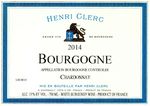 |
| Bourgogne Blanc |
| The Henri Clerc Bourgogne Blanc is about as good as generic white Burgundy gets. The fruit comes from several hillside sites in the villages of Puligny and Meursault. The grapes are meticulously sorted both in the vineyard and the winery to eliminate unhealthy fruit. They are immediately gently pressed in a pneumatic press to retain maximum fruit and aromatic extraction. The must is kept in tanks at low temperatures for 7 days before being transferred to 500 liters oak barrels (of which 10% are new) for alcoholic fermentation and maturation. Only native yeasts, present on the grapes skins, are used. The Bourgogne Blanc matures in barrels on its lees with minimal bâtonnage, or stirring of the lees, to ensure the wine’s freshness. Bottling takes place after about 12 months, in accordance with the lunar cycle. It offers all the characteristics that have made the Clerc white Burgundies so widely appreciated: generous and focused fruit and texture, pure pear and green apple flavors, and a long, fresh finish. It represents outstanding value and is a fine introduction to the house style. |
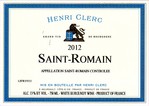 |
| Saint -Romain |
| From 55 year old vines. The vineyard is located in the village of Saint Romain, above Meursault, at an altitude of 350-400 meters, the highest appellation of the Côte d’Or. The soil is pure limestone and the slope is very steep. Guyot pruning with different seasonal processes in the vineyard (pruning, trellising on wires/tying-in, thinning fruit-bunches). The grapes are harvested by hand and sorted out twice (when picking the grapes and on the sorting table). They are then lightly pressed in a pneumatic press at a low pressure to get a slow extraction. After a gentle racking of the must, the wine is put in 500 liters French oak casks (15% of new oak) for both alcoholic and malolactic fermentations with wild yeasts. It is aged for 12 months, with occasional stirring of the lees. A month before the bottling, the wine from the different barrels is transferred to a stainless steel tank to make the blend. It is fined and lightly filtered before bottling, which is done according to the lunar calendar, on a “fruit” day. Henri Clerc’s St Romain is very ripe and full flavored. Expressive bouquet and flavors of pear, honey and citrus nuanced by notes of spice and harmoniously integrated oak. |
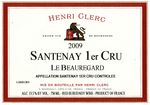 |
| Santenay 1er Cru Le Beauregard |
| The grapes come from 45 year old vines planted in the “Le Beauregard” Premier Cru parcel in the village of Santenay in the south of the Côte de Beaune. “Le Beauregard” vineyard is located on a steep slope just above “Les Gravières”. The soil is clay and limestone. Guyot pruning with different yearly works in the vineyard (pruning, trellising on wires/tying-in, thinning fruit-bunches). The grapes are picked by hand, sorted twice (when picking the grapes and on the sorting table), then partially de-stemmed and put in stainless still thermo-regulated tanks. The alcoholic fermentation begins with natural yeasts and lasts for 3 weeks. Pumping-over is very soft in order to get the purest and most representative wine possible. The wine is put in French oak casks, 20% new and the balance 1-3 years. The malolactic fermentation begins then with natural anaerobic bacterium from the juice. The maturation period is 14 months on fine lees. Bottling is done following the lunar calendar (“fruit day”), with no fining and no filtering. |
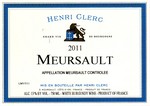 |
| Meursault |
| This Meursault comes from several parcels of vines in the prestigious lieu dits Le Tesson, Les Rougeots and Les Chevalières, all located above the village. The vines, which average 50 years of age, are planted on a steep slope with a stony, limestone-clay soil. The vines are closely pruned and the grape-bunches are regularly thinned to ensure that the fruit is healthy and perfectly ripe at harvest time. The grapes are hand-picked and sorted in the vineyard. The harvest is transported to the winery in small crates and is then lightly pressed in a pneumatic press at low pressure to attain a gentle extraction of aromas and flavors, while avoiding bitterness. The must is kept in tanks at low temperatures for 7 days before transfer to 228 liter oak barrels, of which 15% are new, for alcoholic fermentation and maturation. Only native yeasts, present on the grapes skins, are used. The wine then matures in barrels on its lees with minimal bâtonnage, or stirring of the lees, to ensure the wine’s freshness. Bottling takes place after about 15 months in accordance with the lunar cycle. The flavor and texture are essential Meursault, presenting an interplay of pure and lively citrus fruit, nutty richness, mineral complexity and invigorating, vivid length. |
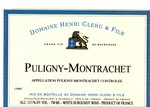 |
| Puligny-Montrachet |
| The Clerc Puligny-Montrachet AOC comes from several parcels with stony- clay-limestone soil lower down on the slope. The vines are pruned to limit production by eliminating excess buds and green-harvesting. Harvest is done entirely by hand. The grapes are meticulously sorted both in the vineyard and the winery to eliminate unhealthy fruit. They are immediately gently pressed in a pneumatic press to retain maximum fruit and aromatic extraction. The must is kept in tanks at low temperatures for 7 days before transferal to oak barrels, of which 15% are new, for alcoholic fermentation and maturation. Only native yeasts, present on the grapes skins, are used. The Puligny-Montrachet AOC matures in barrels on its lees with minimal bâtonnage, or stirring of the lees, to ensure the wine’s freshness. Bottling takes place after about 15 months in accordance with the lunar cycle. This cuvée is pure Puligny: focused, racy and pure, with notes of crisp tropical and pear fruit and an enjoyably long finish. It has a focused texture balanced with a lively acidity the French would call “nervosité.” |
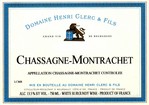 |
| Chassagne-Montrachet |
| The Chassagne-Montrachet AOC comes from several south-east facing parcels with limestone clay soil. The vines average 40 years of age and are pruned to limit production by eliminating excess buds and green-harvesting. Harvest is done entirely by hand. The grapes are meticulously sorted both in the vineyard and the winery to eliminate unhealthy fruit. They are immediately gently pressed in a pneumatic press to retain maximum fruit and aromatic extraction. The must is kept in tanks at low temperatures for 7 days before transferal to oak barrels, of which 15% are new, for alcoholic fermentation and maturation. Only native yeasts, present on the grapes skins, are used. The Chassagne AOC matures in barrels on its lees with minimal bâtonnage, or stirring of the lees to ensure the wine’s freshness. Bottling takes place after about 15 months, in accordance with the lunar cycle. This cuvée is exceptionally generous, elegant and full flavored for a village wine. The flavor is pure Chassagne, with a rich texture and notes of citrus and pear fruit, minerals and spice. |
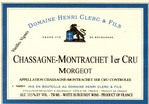 |
| Chassagne-Montrachet - Morgeot 1er cru |
| The Chassagne-Montrachet 1er Cru Morgeot is an expressive, generously textured, full-bodied Chassagne. It is made from 50 year old vines located near the Abbey of Morgeot on a primarily stony, limestone soil. The gentle, south-east facing slope enhances ripening. Harvest is done entirely by hand. The grapes are meticulously sorted both in the vineyard and the winery to eliminate unhealthy fruit. They are immediately gently pressed in a pneumatic press to retain maximum fruit and aromatic extraction. The must is kept in tanks at low temperatures for 7 days before being transferred to oak barrels, of which 30% are new, for alcoholic fermentation and maturation. Only native yeasts, present on the grapes skins, are used. The wine matures in barrels on its lees with minimal bâtonnage, or stirring of the lees, to ensure the wine’s freshness. Bottling takes place after about 15 months in accordance with the lunar cycle. This a powerful white Burgundy with a potential for 5 or more years of aging. |
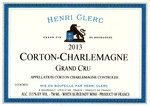 |
| Corton-Charlemagne |
| The vines are located in three, ideally exposed south/southeast facing parcels on the coutour of the Corton-Charlemagne vineyard in the communes of Pernand-Vergelesses, Aloxe-Corton and Ladoix-Serrigny. The vines average 55 years of age. The soil is a classic mix of clay and limestone. The Corton-Charlemagne grapes are harvested by hand and sorted in the vineyard. They are lightly pressed in a pneumatic press at a low pressure to attain a slow and soft extraction. After a gentle racking of the must, the wine is put in 228 litre French oak casks (1/3 each new, one year and two years) for both of the alcoholic and malolactic fermentations. It is then aged on its lees in casks for 18 months with minimal bâtonnage, in keeping with the Clerc style. A month before the bottling, the barrels are assembled into a stainless steel tank. The wine is fined and lightly filtered before bottling, according to the lunar calendar ("root” day for the wines for aging). The 2013 Clerc Corton-Charlemagne has an expressive bouquet of green apples, minerals, white flowers and lemon zest. Stony and pure, full-bodied citrus and spice flavors lead to a long and persistent finish. The Grand Cru concentration is balanced by the accessibility of the 2013 vintage, and any restraint and agreeable tension is resolved by a brief aeration in the glass or decanting. |
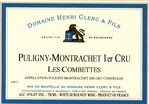 |
| Puligny-Montrachet - Combettes 1er Cru |
| On the same level on the slope as the Grands Crus, the Puligny-Montrachet Les Combettes 1er Cru is the richest of the Clerc Pulignys. It is made from 40-year-old vines on a stony, limestone soil. The must is kept in tanks at low temperatures for 7 days before transfer to oak barrels (of which 30% are new) for alcoholic fermentation and maturation. Only native yeasts, present on the grapes skins, are used. Les Combettes matures in barrels for 15 months on its lees with minimal bâtonnage, or stirring of the lees, to ensure the wine’s freshness. It is a wine of tremendous depth, breed and complexity that is at the level of a Grand Cru. It combines the intensity of Puligny with the generosity of the Meursault Charmes, which it borders. Clive Coates aptly calls the Puligny Les Combettes a most “complete” wine. |
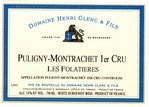 |
| Puligny-Montrachet - Folatières 1er Cru |
| The Puligny-Montrachet 1er Cru Les Folatières, made from 55-year-old vines, is a classic Puligny: elegant, linear, racy and powerful. Harvest is done entirely by hand. The grapes are meticulously sorted both in the vineyard and the winery to eliminate unhealthy fruit. They are immediately gently pressed in a pneumatic press to retain maximum fruit and aromatic extraction. The must is kept in tanks at low temperatures for 7 days before transferal to oak barrels (of which 30% are new) for alcoholic fermentation and maturation. Only native yeasts, present on the grapes skins, are used. The wine matures in barrels on its lees with minimal bâtonnage, or stirring of the lees, to ensure the wine’s freshness. Bottling takes place after about 15 months in accordance with the lunar cycle. The flavor and texture are pure Puligny, with vivid fruit aromas and flavors of citrus, pear and white peach, nuanced with minerals and oak. It is full on the palate, with pleasing richness and verve. |
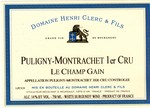 |
| Puligny-Montrachet - Champ Gain 1er Cru |
| Situated on the uppermost part of the on the slope, Clerc’s Puligny-Montrachet Les Champs Gains 1er Cru was planted in 1965. There is thin layer of soil over stony, limestone subsoil. Harvest is done entirely by hand. The grapes are meticulously sorted both in the vineyard and the winery to eliminate unhealthy fruit. They are immediately gently pressed in a pneumatic press to retain maximum fruit and aromatic extraction. The must is kept in tanks at low temperatures for 7 days before transferal to oak barrels, of which 25% are new, for alcoholic fermentation and maturation. Only native yeasts, present on the grapes skins, are used. The wine matures in barrels for 15 months on its lees with minimal bâtonnage, or stirring of the lees, to ensure the wine’s freshness. Distinct minerality, length and structure, with bright green apple, citrus zest and white peach fruit. |
| Bienvenues-Bâtard Montrachet - Grand Cru |
| Clerc’s Bienvenues-Bâtard Montrachet Grand Cru drinks beautifully. It is the most forward of the Grands Crus. This is a pillowy wine, which envelopes the palate with layers of richness. Flavors of lanolin, honey and peach, mixed with nuances of oak, gives this wine its Grand Cru breed and finesse. |
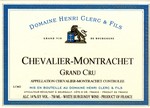 |
| Chevalier-Montrachet - Grand Cru |
| The majestic Chevalier-Montrachet Grand Cru comes from 25 year old vines. It is always the most structured of Clerc’s wines, taking about 5 years to show its richness and complexity. Lush flavors of nutty, honeyed, and spicy fruit will appear, making this wine a perfect match with rich dishes. |
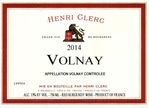 |
| Volnay |
| Clerc’s Volnay AOC expresses the appellation’s unique trait: aromatic and expressively fruity Pinot Noirs that are not accompanied by a pronounced tannic structure and so are accessible when young. The vines average 65 years of age and are located on the lower third of the Volnay slope, below the 1er Crus. The grapes are hand-picked, carefully sorted, and given two days of pre-fermentation cold maceration. The alcoholic fermentation begins with the aid of only native yeasts and lasts for three weeks with several delicate pumping-over operations. The goal is to extract only supple and pure fruit flavors and aromas, while avoiding harsh elements. The wine is then aged in casks (15% new, with the rest between one and three year old) for 14 months. It is bottled in February without fining or filtration. The bottling date is selected according the lunar calendar, at the moment of the waning moon, which naturally clarifies the wine. Aromatic, fruity, fresh and elegant wine with aromas and flavors of violets, dark cherry and plums. |
| Copyright © 2002-2017 VOS Selections, Inc. |